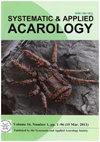蛇蜱的寄主组合——安氏虫,1899(Ixodida:Ixodidae),台湾新的寄主记录
IF 1.2
3区 农林科学
Q2 ENTOMOLOGY
引用次数: 0
摘要
摘要蜱Amblyomma cordiferum Neumann, 1899是一种罕见的东半球爬行动物相关物种,主要寄生在蛇身上。这种蜱虫来自印度尼西亚、马来西亚、新加坡、台湾、泰国和萨摩亚。在台湾,A. cordiferum曾在Elaphe carinata (g本文章由计算机程序翻译,如有差异,请以英文原文为准。
Host associations of the snake tick Amblyomma cordiferum Neumann, 1899 (Ixodida: Ixodidae), with new host records from Taiwan
Abstract The ixodid tick Amblyomma cordiferum Neumann, 1899 is an uncommonly collected Old World reptile-associated species that is primarily ectoparasitic on snakes. This tick is known from Indonesia, Malaysia, Singapore, Taiwan, Thailand, and Samoa. In Taiwan, A. cordiferum has previously been reported on Elaphe carinata (Günther), Elaphe taeniura (Cope), and Ptyas mucosa (Linnaeus). In this paper, we examined a total of 246 specimens of A. cordiferum from recent and old collections. Here we report new Taiwan records of A. cordiferum parasitizing the Chinese cobra, Naja atra Cantor, many-banded krait, Bungarus multicinctus Blyth, and yellow-spotted keelback, Fowlea flavipunctatus (Hallowell). This is also the first report of A. cordiferum parasitizing members of the venomous family Elapidae in Taiwan, as well as the first report of A. cordiferum parasitizing a member of the colubrid genus Fowlea Theobald. An updated host-parasite list summarizes all known hosts of A. cordiferum throughout this tick's geographic range.
求助全文
通过发布文献求助,成功后即可免费获取论文全文。
去求助
来源期刊

Systematic and Applied Acarology
ENTOMOLOGY-
CiteScore
2.20
自引率
33.30%
发文量
152
期刊介绍:
Systematic and Applied Acarology (SAA) is an international journal of the Systematic and Applied Acarology Society (SAAS). The journal is intended as a publication outlet for all acarologists in the world.
There is no page charge for publishing in SAA. If the authors have funds to publish, they can pay US$20 per page to enable their papers published for open access.
SAA publishes papers reporting results of original research on any aspects of mites and ticks. Due to the recent increase in submissions, SAA editors will be more selective in manuscript evaluation: (1) encouraging more high quality non-taxonomic papers to address the balance between taxonomic and non-taxonomic papers, and (2) discouraging single species description (see new special issues for single new species description) while giving priority to high quality systematic papers on comparative treatments and revisions of multiple taxa. In addition to review papers and research articles (over 4 printed pages), we welcome short correspondence (up to 4 printed pages) for condensed version of short papers, comments on other papers, data papers (with one table or figure) and short reviews or opinion pieces. The correspondence format will save space by omitting the abstract, key words, and major headings such as Introduction.
 求助内容:
求助内容: 应助结果提醒方式:
应助结果提醒方式:


